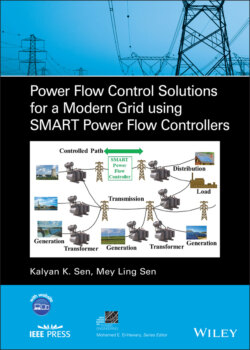Читать книгу Power Flow Control Solutions for a Modern Grid Using SMART Power Flow Controllers - Kalyan K. Sen - Страница 27
1.6 SMART Power Flow Controller (SPFC)
ОглавлениеToday’s power grid, shown in Figure 1-35, has integrated 100s of MW‐range renewable generation. The primary driving factor for integrating more clean, renewable energy sources to the grid is the desire to reduce the use of carbon‐based generation, which will lower GHG emissions. However, a typical characteristic of renewable energy, i.e. solar photovoltaic and offshore or land‐based wind, is the intermittent nature and the resulting unsteady power flow to the load centers. To avoid resulting brown‐outs and/or black‐outs from this intermittency, the power flow in a transmission line needs to be controlled by using a SMART PFC (SPFC) that provides the needed dynamic response. So, traditional steady‐state PFCs, such as series‐connected reactor and capacitor need to be updated with an improved dynamic response. Additionally, there is an increased need for a bidirectional power flow when the renewable generation is unavailable.
Free flow of electricity may cause some transmission lines to be overloaded or underloaded. The congestions due to overloaded lines exist throughout the transmission network. The congestion points, referred to as bottlenecks, prevent desirable clean energy to reach desired load centers. When a line is congested, the present practice is to curtail renewable generation in front of the emerging bottleneck and turn on local, possibly, nongreen generation behind the bottleneck to meet the demand for electricity.
Successful transition to clean energy depends on the ability to generate and distribute renewable energy through the transmission and distribution networks. The intermittency of energy sources, need for bidirectional flows, remote locations of solar and wind projects, and so on, are challenging grid planners and operators to integrate more renewable energy into the grid. Even before the meaningful penetration of renewables is reached, forecasters are factoring renewable curtailment as a major strategy to balance supply and demand.
An SPFC, such as an IR with a proper dynamic response capability, can greatly aid in fulfilling these new requirements. The SPFC creates a variable virtual impedance that can be connected in series with the line, to maintain steady power flows to the load centers. The SPFC can limit the power flow in congested lines to be within their ATC so that the renewable generation does not need to be curtailed.
As discussed in great detail in Chapter 2, any PFC that connects a compensating voltage in series with the line is actually an IR, except an SSSC, which is a RR. The PAR acts as an IR in an indirect way with no capability to select the compensating resistance (Rse) and reactance (Xse) independently as discussed in Chapter 2, Section 2.2.2.6. Therefore, a true IR that emulates a four‐quadrant, series‐compensating impedance (Zse = Rse − jXse) that consists of a resistance (Rse = +R or − R) and a reactance (Xse = XC or − XL) in series with the line is really needed. Additionally, increasing the installation of roof‐top solar as generation and its integration into a low voltage distribution network alters the traditional feeder voltage profile in the distribution networks, which can be mitigated, using an IR.
Figure 1-35 Today’s grid with traditional generation and integrated renewable generation.
Advances in power electronics have made it possible to develop the UPFC, which is an IR. The VSC‐based UPFC is capable of providing responses in the range of ms as shown in Figure 1-13 in the demonstration of the first commercial STATCOM at TVA Sullivan substation in 1995. However, the experiences from the last three decades show that the needed response time is in seconds in most utility applications as shown in Figures 1-29 and 1-30 in the demonstration of world’s first UPFC at AEP Inez substation. Nevertheless, the cost of a UPFC is about the same, whether it is used in slow‐response or fast‐response applications. Therefore, it is desirable to explore the alternate designs of an IR that meet the functional requirements to provide independent control of active and reactive power flows with responses in seconds and at a fractional amount of the cost of VSC‐based FACTS Controllers. This was the motivation to develop an SPFC whose objectives are as follows:
S – specific (design a power flow controller that meets utilities’ needs)
M – measurable (high reliability, high efficiency, cost‐effectiveness, component non‐obsolescence, and ease of relocation)
A – attainable (realistic expectation about the outcome)
R – relevant (efficient power grid)
T – time‐bound (delivery milestones).
The SPFC can control a bidirectional and independent active and reactive power flows dynamically as shown in Figure 1-36.
